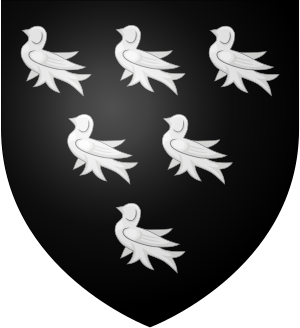Humphrey Arundell facts for kids
Humphrey Arundell (born around 1513, died 1550) was an important leader from Helland in Cornwall. He led the Cornish people during a big uprising called the Prayer Book Rebellion. This happened early in the reign of King Edward VI. Sadly, after the rebellion was defeated, Humphrey Arundell was executed in Tyburn, London.
Contents
Who Was Humphrey Arundell?
Humphrey Arundell was the oldest son of Roger Arundell (who died in 1536) and Johanna Calwoodleigh (who died in 1537). His family owned a lot of land in both Cornwall and Devon. His mother's father, Humphry Calwoodleigh, had been involved in an earlier uprising in 1497. Humphrey's family, the Arundells of Lanherne, were quite powerful in Cornwall. His great-uncle, John Arundell, was a very important person in the Duchy of Cornwall.
Leading the Rebellion
Humphrey Arundell was born in Helland, near Bodmin in Cornwall. He was an experienced soldier. In 1549, he became the leader of the Cornish army. This army gathered first in Bodmin. They were involved in the Cornish rebellion of 1549, also known as the Prayer Book Rebellion. Before this, Humphrey had been in charge of a small group of soldiers at St Michael's Mount. This group joined the rebels at the start of the uprising.
Why the Rebellion Started
The rebellion was against King Edward VI. A big reason for it was a new English prayer book. Many Cornish people didn't understand English very well. They preferred the old Latin church services. The Cornishmen outside the walls of Exeter clearly stated, "and so we Cornishmen, whereof certain of us understand no English, utterly refuse this new English."
Battles and Capture
During the 1549 siege of Exeter, Arundell and his troops didn't have much heavy artillery. They had taken some smaller guns from Plymouth and other forts belonging to the King. These included guns from St Michael's Mount, St Mawes Castle, Pendennis Castle, and Trematon Castle.
At the battle of Sampford Courtenay, Humphrey Arundell led a large group of rebels from the back. This caused confusion among the King's soldiers. The rebels had to make another stand at Okehampton. Then they fell back to Launceston. There, Humphrey Arundell was finally defeated and put in the castle prison.
On August 19, he was moved to the dungeons of Rougemont Castle in Exeter. In September, he was taken with other rebels to the Tower of London.
Trial and Execution
In November 1549, Humphrey Arundell was taken to Westminster Hall. He was found guilty of high treason. This meant he was accused of betraying the King. He was sentenced to be taken back to the Tower and later executed. He was executed on January 27, 1550. After his death, the lands of the rebellion leaders were given to those who had helped the King. Sir Gawen Carew received most of Humphrey Arundell's lands.
Other Cornish leaders from an earlier rebellion in 1497, like Thomas Flamank and Michael An Gof, had also been executed at Tyburn.
Family Life
Humphrey Arundell married Elizabeth Fulford (who died in 1565). She was the daughter of Sir John Fulford of Great Fulford in Devon. Her mother was Dorothy Bourchier, whose father was John Bourchier, 1st Earl of Bath. It seems Humphrey Arundell did not have any children. Elizabeth Fulford outlived him and later married Thomas Carey.
See also


